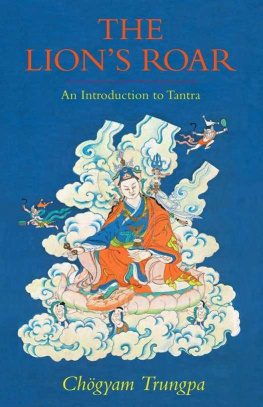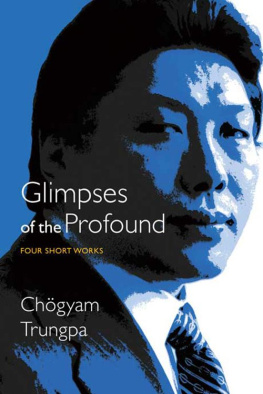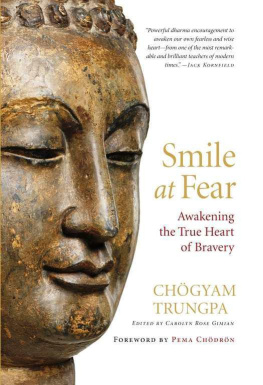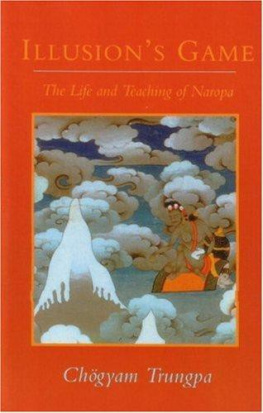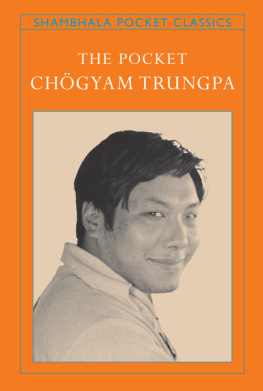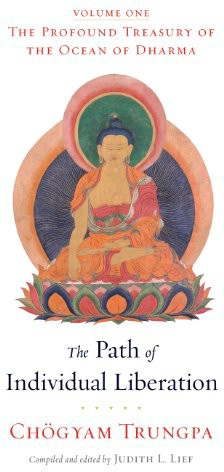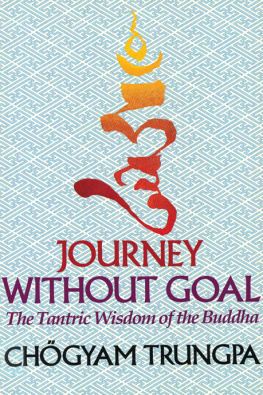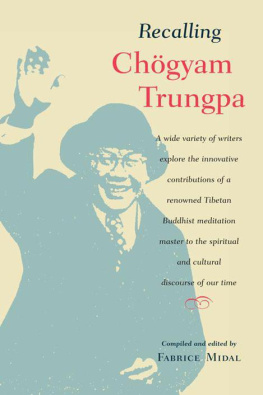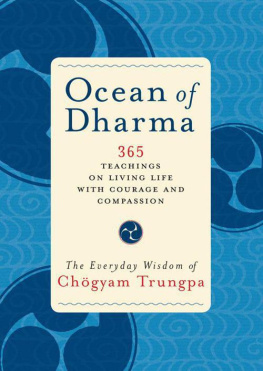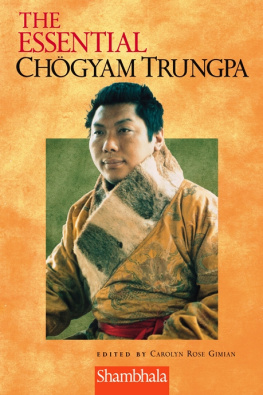The Lions Roar
AN INTRODUCTION TO TANTRA
Chgyam Trungpa
Edited by Sherab Chdzin

Shambhala Boston & London 2010
S HAMBHALA P UBLICATIONS , I NC .
Horticultural Hall
300 Massachusetts Avenue
Boston, Massachusetts 02115
www.shambhala.com
1992 by Diana J. Mukpo
All rights reserved. No part of this book may be reproduced in any form or by any means, electronic or mechanical, including photocopying, recording, or by any information storage and retrieval system, without permission in writing from the publisher.
Library of Congress Cataloging-in-Publication Data
Trungpa, Chgyam, 1939
The lions roar: an introduction to tantra / Chgyam Trungpa;
edited by Sherab Chdzin.1st ed.
p. cm.(Dharma ocean series)
Includes index.
eISBN 978-0-8348-2139-2
ISBN 0-87773-654-5
ISBN 1-57062-895-5
1. Tantric BuddhismDoctrines. 2. Spiritual lifeTantric Buddhism. 3. Tantric BuddhismChinaTibet.
I. Chdzin, Sherab II. Title. III. Series: Trungpa, Chgyam, 1939 Dharma ocean series.
BQ8918.T79 1992 91-50365
294.3925dc20 CIP
Contents
Editors Foreword
T HE TWO SEMINARS that make up this book were given by Vidyadhara the Venerable Chgyam Trungpa Rinpoche, in May 1973 in San Francisco, and December 1973 in Boulder, Colorado, respectively. Each bore the title The Nine Yanas. Yana is a Sanskrit word meaning vehicle. It refers to a body of doctrine and practical instruction that enables students to advance spiritually on the path of buddhadharma. Nine yanas, arranged as successive levels, make up the whole path. Teaching nine yanas means giving a total picture of the spiritual journey.
To give this total picture in 1973 meant a new departure for the Vidyadhara Trungpa Rinpoche in his teaching in the West. It meant introducing tantra, or vajrayana, because the last six of the nine yanas are tantric yanas. Until the San Francisco seminar, though students understood that the Vidyadharas ultimate perspective was tantric, and though he often spoke in general terms about the tantric approach, specific details were taboo. He turned aside prying questions about tantra with humor, derision, intimidation, evasion, or whatever other means was handy.
Then he embarked on a new phase in his teaching. In May he gave the San Francisco seminar, introducing tantra for the first time as a level of teaching that could actually become available to his students if they worked through the preceding levels. In the fall he taught the Vajradhatu Seminary, the first in a long series of yearly three-month practice-and-study intensives that took the form of detailed instruction on the nine yanas. The seminaries were not public. Here students who had already received appropriate training were prepared to enter upon tantric practice. Immediately after that first seminary, in December, the Vidyadhara taught the nine yanas to the public again in Boulder, once again holding out the possibilities of the complete path. This time, after each of his own talks, he had one of his students fresh from seminary explain something of what he had understood and experienced there.
Tantra is an astonishing doctrine. It seems to come out of primordial depths of experience and run at all kinds of odd angles to convention and conceptual thinking. It eludes these two would-be stabilizers of human experience; therefore the presentation of it is shocking and raw. One of the slogans that comes out of the tantric Buddhist tradition of Tibet is tampe tn ni jikpa me , which the Vidyadhara chose to translate, The proclamation of truth is fearless. He made that the motto of Vajradhatu, the religious organization he founded, and that motto strongly characterizes the seminars we have before us.
Traditionally the elements of a situation in which the dharma is transmitted are enumerated as the right teacher, teaching, place, time, and students. All five shape the event. The last three factors shaping these two seminars can be evoked most simply by recalling that this was the time in America of hippies and the spiritual supermarket. It was a period that was a crack between periods. One social minibubble of manners and outlooks had been punctured and let, another had yet to inflate. It was a moment of openness, of exuberance and candor.
Perhaps these elements provide a partial explanation of the extraordinary qualities of the Vidyadhara Trungpa Rinpoches teaching. In it, there is a near absence of protective reserve. Guarding and cherishing the essence of tradition, he steps beyond its stone walls to meet his students on open ground. He does not rely on established doctrinal formulations, but speaks from a nonconceptual, essential understanding of things and explains them in terms experiential for his audience. After he has already made an experience clear, he might say, In fact the traditional metaphor is... or The traditional term for this is... He sometimes referred to his unique style of displaying the inner heart of the teaching without focusing on its outer details as fingerpainting. This book is an excellent example of how his fingerpainting can directly communicate insight far beyond the pale of conventional understanding. He does not present us with airtight rehearsals of doctrine. To any audience, then or now, such presentations can become like displays in a glass case in a museum, remote though perhaps fascinating. Instead, here, the complete teachings of buddhadharma are presented fresh and raw, with their odor intact, as personal experience. They are the mighty roaring of a great lion of dharma. Many of those who first heard them are tantric practitioners today.
In this book I have put the Boulder seminar first, because it seemed to provide an easier leg-up for the general reader than the San Francisco one. Chronological purists may want to read them in the other order. I have provided a few explanatory notes for the general reader. Readers with some specialized knowledge can skip them without loss.
May the sound of the great drum of dharma
Eliminate the suffering of sentient beings
May the dharma be proclaimed
Through a million kalpas
S HERAB C HDZIN K OHN
Nova Scotia, 1991
Part One
NINE YANAS SEMINAR
BOULDER
DECEMBER 1973
ONE
The Journey
T HE BUDDHIST JOURNEY is a journey from beginning to end in which the end is also the beginning. This is the journey of the nine yanas, the nine stages that students go through on the path. Yana means vehicle or mode of transport. Once you get onto this particular bandwagon, it is an ongoing journey without reverse and without brakes. You have no control over the horse that is pulling this carriage. It is an ongoing process. Beginning this journey is committing yourself to a particular karmic flow, a karmic chain reaction. It is like being born. When you are born, nobody can say, That was just a rehearsal, and take the whole thing back. Once you are born, you keep on growing up, growing up, getting older, becoming aged, more aged, and then finally you die. When you are born, there is a certain amount of commitment involvedto be born as a human child from a mothers womb, with parents, with a house, and so on.
This journey is a very definite one, absolutely definite, and that is why it is called Buddhism. Although - ism is a rather ugly suffix, it is a definite ism. It is a Buddha-ism, because we are trying to imitate Buddhas journey. And when we try to imitate Buddhas journey, it just so happens that what we are doing becomes an ism. It is a real journey, and it involves a real commitment. It also involves some kind of dogma. It means associating yourself with a certain doctrine, a certain formulation of truth. We are not embarrassed to call ourselves Buddhists. In fact we take pride in it, because we have found a way, a path, that makes it possible for us to associate ourselves with Buddha, the Awakened One. Awakened here means highly awakened, fully awakened, awakened to the point of being entirely sane, to the point where there is no neurosis to confuse our journey. Ours is a completely sane approach. Thus there is room for pride, room for dogma, room for real commitment. That is the quality of the nine-yana journey.
Next page
